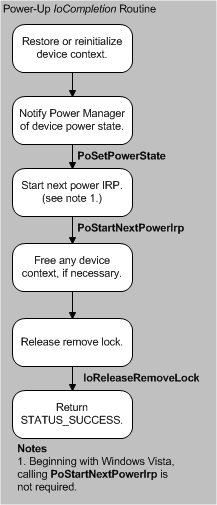IoCompletion Routines for Device Power IRPs
After the bus driver completes the IRP, the I/O manager calls the IoCompletion routines registered by higher-level drivers as they passed the IRP down the stack.
Whenever a device enters the D0 state, each of its drivers should set an IoCompletion routine that performs most of the tasks required to return it to the working state. Drivers should set an IoCompletion routine for any transition to the D0 state, whether the device is returning from a sleeping state or entering D0 at system start-up. The following figure shows the tasks such an IoCompletion routine should perform.

These tasks include:
Restoring device power state or reinitializing the device, as required, and preparing to handle any I/O queued by drivers while the device was not in the working state
Calling PoSetPowerState to notify the power manager that the device is in the D0 power state.
Calling PoStartNextPowerIrp to receive the next power IRP, if the driver did not originally send the current power IRP. (Windows Server 2003, Windows XP, and Windows 2000 only).
Freeing memory allocated for the device context.
Calling IoReleaseRemoveLock to free the lock that the driver acquired in its DispatchPower routine when it received the IRP.
Returning STATUS_SUCCESS.
The bus driver does not power up the device until it or higher drivers must communicate with the device.
When its device enters a sleeping state, a driver should set an IoCompletion routine that calls PoStartNextPowerIrp (Windows Server 2003, Windows XP, and Windows 2000 only) and releases the remove lock. Remember that a driver cannot access its device while the device is in a sleeping state.
Feedback
Coming soon: Throughout 2024 we will be phasing out GitHub Issues as the feedback mechanism for content and replacing it with a new feedback system. For more information see: https://aka.ms/ContentUserFeedback.
Submit and view feedback for